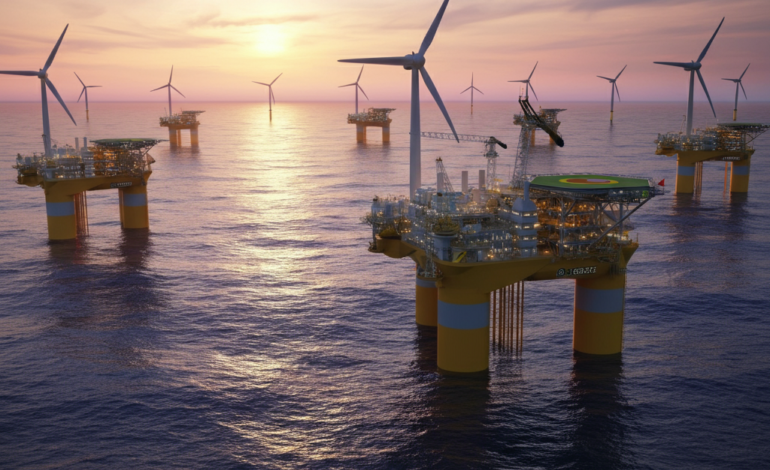Deep Offshore Technology: Revolutionizing the Future of Energy

Deep offshore technology stands on the frontier of innovation and challenges in the energy sector. Its potential to produce massive energy resources—ranging from oil and gas to renewable wind—makes it a key player in powering our future. But operating in these extreme environments is not without its complexities.
This blog will walk you through the world of deep offshore technology, exploring its innovations, the challenges it faces, and the potential it holds for reshaping global energy.
Understanding Deep Offshore Technology
What is Deep Offshore Technology?
Deep offshore technology refers to the systems, tools, and processes employed to explore, extract, and manage energy resources located in deep or ultra-deep waters. Typically, these offshore locations are at water depths exceeding 300 meters (1,000 feet). This subset of marine technology encompasses oil and gas extraction, renewable energy generation, and the engineering solutions required to operate in such harsh environments.
Why is Deep Offshore Technology Important?
The significance of deep offshore technology has grown year by year—both as a source of energy and an arena for innovation. The increasing global energy demand, coupled with the depletion of easily accessible energy reserves, has spurred investment in offshore exploration.
To contextualize its importance:
- 10% of the world’s oil supply comes from deep offshore production, amounting to an impressive 7.5 million barrels of oil per day as of 2021.
- 3.6 gigawatts (GW) of global offshore wind capacity originates from deep offshore sites, marking a 19% growth year-on-year (2020).
Deep offshore technology is not just about enabling energy extraction; it opens the doors to untapped reserves of hydrocarbons and renewable energy potential, making it essential for the global energy transition.
Innovations in Deep Offshore Technology
Innovation is at the core of deep offshore operations, allowing us to meet energy needs efficiently and sustainably.
Cutting-Edge Advancements in Deep Offshore Energy
Technological progress has significantly expanded the possibilities of deep-water exploration and production. Among the most noteworthy innovations are:
- Subsea Robotics and Drones: These autonomous technologies assist in underwater inspections, repairs, and equipment installations, reducing human exposure to dangerous conditions.
- Floating Production Storage and Offloading (FPSO) Units: FPSOs, like the Prelude FLNG platform, symbolize engineering marvels. These floating units extract, process, and store energy resources in remote, deep-water locations.
- AI in Monitoring and Maintenance: AI-powered systems now oversee offshore platforms, enhancing safety, predicting maintenance needs, and cutting operational costs.
Case Studies of Implementation
Prelude FLNG Facility (Australia)
The first of its kind, Shell’s Prelude FLNG is the largest floating offshore platform globally, redefining liquefied natural gas (LNG) production. Its ability to produce 3.6 million tonnes of LNG annually highlights the scalability of offshore technology.
Hywind Scotland (United Kingdom)
Developed by Equinor, this innovative floating wind farm supplies 20,000 households with renewable energy, proving the viability of deep-water wind installations.
Ormen Lange Gas Field (Norway)
Using subsea compression technology, the Ormen Lange project has substantially increased recoverable reserves, showcasing how innovation helps overcome the challenges of ultra-deep environments.
Challenges in Deep Offshore Technology
Despite its potential, challenges in deep offshore technology range across environmental, safety, and technical domains.
Environmental Concerns
- Impact on Marine Ecosystems: Offshore drilling and renewable installations can disrupt fragile marine life. Mitigation strategies include advanced impact assessments and environmentally friendly operation protocols.
- Carbon Footprint: Extracting hydrocarbons from ultra-deep waters often involves higher carbon emissions. However, carbon capture technologies and renewable energy adoption are making strides in reducing this.
Safety Challenges
Operating at immense pressures and depths puts workers at significant risk. Enhanced safety technologies like real-time monitoring, automated systems, and emergency response protocols are critical in minimizing accidents.
Technical and Operational Difficulties
- Extreme Conditions: Temperatures near freezing and water pressures that could crush steel make deep-sea operations highly challenging.
- Infrastructure Durability: Ensuring the longevity of subsea pipelines and equipment in corrosive saltwater environments is an ongoing challenge.
- High Costs: Developing and deploying technologies like FPSOs or floating wind turbines demands significant investment. Organizations must strike a balance between costs and profitability.
The Future of Deep Offshore Technology
The next decade will be pivotal for deep offshore technology, driven by advancements in innovation and a global shift toward sustainability.
Growth Potential
The global deep offshore technology market is set to reach $93.06 billion by 2026, growing at a CAGR of 7.4%. With advancements in tools and AI-driven solutions, this sector is set to play an even more critical role in fulfilling energy demands.
Opportunities in Renewables
Floating offshore wind farms, which can operate in deep-sea areas, are a major growth area. With technologies like Hywind proving their viability, global renewable offshore capacity is expected to double by 2030.
Predictions for the Next Decade
- AI and Automation Will Dominate**: From predictive maintenance systems to fully automated FPSOs, AI will drive efficiency.
- Hydrogen Production at Sea: Combining offshore wind farms with hydrogen production units at deep-sea sites has enormous potential for clean energy economies.
- Rising Subsea Cities: Advanced subsea systems may pave the way for offshore installations resembling small self-sustaining urban centers.
Driving the Future of Energy
Deep offshore technology represents one of the last frontiers in energy production—an area rich in resources and innovation. With its ability to tap into untapped reserves while exploring renewable potential, it holds the promise of fueling global needs more sustainably. That said, the challenges of operation demand equally focused attention on environmental safety and risk mitigation.
Businesses, governments, and innovators must work together to scale these technologies while protecting our oceans’ ecosystems. The future of energy is deep offshore—are you ready to explore what lies beneath?
For more insights and opportunities in adopting energy technologies, subscribe to our newsletter today.







